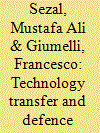| Srl | Item |
| 1 |
ID:
173121


|
|
|
|
|
| Summary/Abstract |
Drawing upon 106,181 patent applications by the world’s largest defense firms and 241,571 patent citations (2002–2011), this article has two main objectives. The first is to explore the factors affecting the production of mixed patents (those with potential dual applications in both military and civilian spheres). The second is to identify the causes of the use of military knowledge for civilian inventions (spin-off) and the use of civilian knowledge in military patented technologies (spin-in). Our calculations show highly significant coefficients for the variables capturing the “military technological capability” and the size of the company in explaining the production of mixed technologies. The spin-off process is affected by the military technological capability, the size of the firm, and the location. The spin-in mechanism is explained by the military technological capability and the location of the firm, while the size of the company is not relevant.
|
|
|
|
|
|
|
|
|
|
|
|
|
|
|
|
| 2 |
ID:
187501


|
|
|
|
|
| Summary/Abstract |
State defence and security policies rely mostly on their military capabilities. The latter are ensured through research and development (R&D) as well as procurement, which are subject to defence industry dynamics. Furthermore the defence sector is heavily dependent on public funds; the latter can be more easily allocated if related R&D has a spill-over effect on the civilian sector, creating the potential for a bigger and more globally (or regionally) integrated market. This article investigates, then, how technology moves, and whether defence sector innovations create spin-offs in the civilian sector in the Netherlands. We aim to provide an industry-centred perspective on defence sector dynamics and potentials. For this, the article attempts to answer the following questions: Are defence technologies transferred to the civilian sector? What lessons can be derived from the Dutch case? To address these research puzzles the article’s theoretical framework builds on the technology-transfer literature in analysing the case study of the Netherlands. The basis for this is 23 interviews with representatives of Dutch defence companies that were carried out both in a workshop and in one-to-one settings in May and June 2020.
|
|
|
|
|
|
|
|
|
|
|
|
|
|
|
|